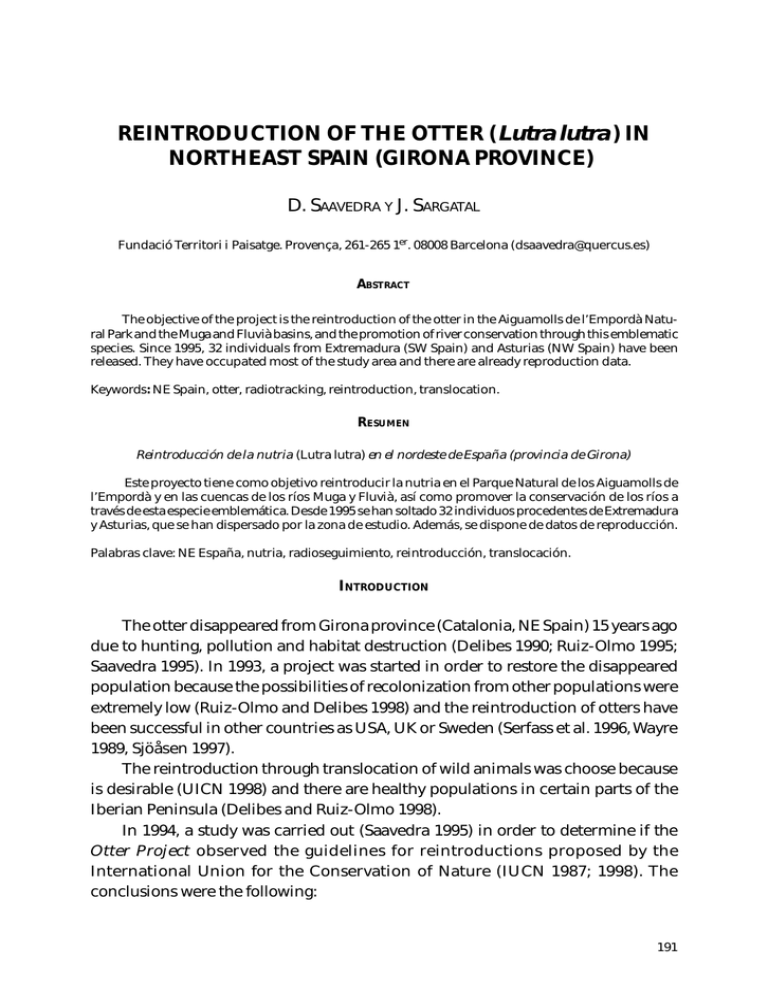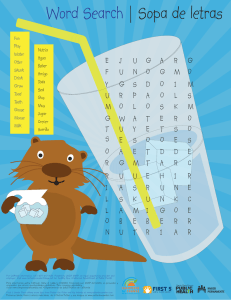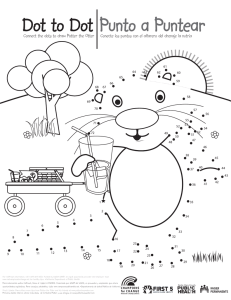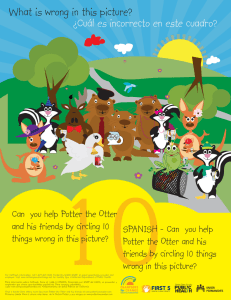REINTRODUCTION OF THE OTTER (Lutra lutra) IN NORTHEAST
Anuncio

Reintroduction of the otter in NE Spain REINTRODUCTION OF THE OTTER ( Lutra lutra ) IN NORTHEAST SPAIN (GIRONA PROVINCE) D. SAAVEDRA Y J. SARGATAL Fundació Territori i Paisatge. Provença, 261-265 1er. 08008 Barcelona ([email protected]) ABSTRACT The objective of the project is the reintroduction of the otter in the Aiguamolls de l’Empordà Natural Park and the Muga and Fluvià basins, and the promotion of river conservation through this emblematic species. Since 1995, 32 individuals from Extremadura (SW Spain) and Asturias (NW Spain) have been released. They have occupated most of the study area and there are already reproduction data. Keywords: NE Spain, otter, radiotracking, reintroduction, translocation. RESUMEN Reintroducción de la nutria (Lutra lutra) en el nordeste de España (provincia de Girona) Este proyecto tiene como objetivo reintroducir la nutria en el Parque Natural de los Aiguamolls de l’Empordà y en las cuencas de los ríos Muga y Fluvià, así como promover la conservación de los ríos a través de esta especie emblemática. Desde 1995 se han soltado 32 individuos procedentes de Extremadura y Asturias, que se han dispersado por la zona de estudio. Además, se dispone de datos de reproducción. Palabras clave: NE España, nutria, radioseguimiento, reintroducción, translocación. INTRODUCTION The otter disappeared from Girona province (Catalonia, NE Spain) 15 years ago due to hunting, pollution and habitat destruction (Delibes 1990; Ruiz-Olmo 1995; Saavedra 1995). In 1993, a project was started in order to restore the disappeared population because the possibilities of recolonization from other populations were extremely low (Ruiz-Olmo and Delibes 1998) and the reintroduction of otters have been successful in other countries as USA, UK or Sweden (Serfass et al. 1996, Wayre 1989, Sjöåsen 1997). The reintroduction through translocation of wild animals was choose because is desirable (UICN 1998) and there are healthy populations in certain parts of the Iberian Peninsula (Delibes and Ruiz-Olmo 1998). In 1994, a study was carried out (Saavedra 1995) in order to determine if the Otter Project observed the guidelines for reintroductions proposed by the International Union for the Conservation of Nature (IUCN 1987; 1998). The conclusions were the following: 191 Galemys 10 (nº especial), 1998 1. The Eurasian otter is classified as Vulnerable for its total distribution (IUCN 1990) and for Spain (Blanco and González 1992). 2. The reintroduction has been proposed in the Aiguamolls de l’Empordà Natural Park and Muga and Fluvià basins, which are part of the original area of distribution (Delibes 1990; Ruiz-Olmo and Aguilar 1995; Ruiz-Olmo 1995). 3. The causes of extinction were persecution (hunting, trapping), pollution and habitat destruction (Ruiz-Olmo 1995; Saavedra 1995). 4. Extinction in the study area has been complete, with the last citation in 1984 (Delibes 1990). Between Muga and Fluvià basins and the nearest otter populations there are several basins without otters, so spontaneous recolonization is unlikely to occur (Ruiz-Olmo and Delibes 1998). 5. The proposed donor populations (from Extremadura, Galicia, Asturias and Portugal) are healthy and increasing in number (Farinha et al. 1997, RuizOlmo and Delibes 1998). 6. Though there are no specific studies based on genetics, there are no significant morphological differences between the Iberian otters (Ruiz-Olmo 1995). The proposed donor populations are the nearest with enough individuals and live in comparable mediterranean habitats. 7. The extension of the study area is 200,000 ha, with more than 600 km of river and 3,000 ha of wetlands. Considering the densities found in Catalonia (0,1-1,2 otters/km; Ruiz-Olmo 1995), there is enough habitat for a population with a range between 60 and 720 animals. As in other mammal reintroduction projects, the objective is to release 50 otters, because a number smaller disposes a population to inbreeding depression (Gilpin 1987). Nevertheless, this number implies a isolated population that has been decreasing until 50 individuals who are genetically closely related. In our case, the 50 otters will come from different populations and will have a much higher genetic variance. 8. The habitat is in good condition. Riparian and marsh vegetation are well conserved in a major part of the area (Saavedra 1995). Fish biomass varied between 0.6 and 351.9 gr/m2 (n=12) in Zamora et al. 1996 study, with only two sites (17%) with a biomass lower than 8 gr/m2, the minimum value calculated to support an otter population in Mediterranean rivers (RuizOlmo 1995). The levels of organochlorine compounds in fish of the area are in the order of those calculated in rivers of Catalonia (López-Martín et al. 1995). The levels of PCBs, the main compounds associated with the decline of the otter, ranged between 81 and 136.4 µg/kg wet weight (95% CI, n=37), with 41% of the sites with values higher than 110 µg/kg ww (Mateo et al. 192 Reintroduction of the otter in NE Spain 1995). The fishes with levels lower than this ‘level of concern’ live in catalonian rivers with healthy otter populations (Ruiz-Olmo 1995, RuizOlmo and López-Martín 1994). 9. The human local population is mainly in favour of the reintroduction, because the otter does not negatively affect the interests of any economic group in the area (Saavedra 1995). In Spain it’s a fully protected species from 1973. 10. The project has the permission and support of the government agencies. The main objectives of the Otter Project are: - The restoration of an erradicated population. - The promotion of river and wetland conservation through an emblematic species. S TUDY AREA AND METHODS The reintroduction project is being carried out in the Muga and Fluvià river basins, a territory which includes aproximately 2,000 km2. Both are low headwaters Mediterranean rivers with irregular water regime, fed by surface waters (rainfall) and lower flow typified by a low absolute volume. The Muga basin presents a surface of 853.78 km2 and a average flow of 2.44 m2/seg. The total length of its main branch is 64.7 km. The Fluvià river is 97.2 km long, with a mean flow of 1.27 m2/seg and a basin surface of 1123.58 km2 (Brusi 1992). Both rivers flow into Aiguamolls de l’Empordà wetlands, with 4,800 ha protected as Natural Park and 800 ha as Strict Reserve (figure 1). The riparian forests include Populus alba, Fraxinus angustifolia and Alnus glutinosa, but in many places has been replaced with plantations of trees, with Populus nigra and Platanus x hybrida. Helophitic and halophil vegetation (Phragmites sp., Typha sp., Arthrocnemum sp.) occurs on the wetlands and coastal zones (Folch and Franquesa 1984). The fish community is mainly represented by Ciprinidae, with a great proportion of introduced species (Carp, Roach, Rudd) and Anguillidae (Eel). In the upper course Trout is found and near the mouth of both rivers and in the wetlands some marine species (Mullet, Sea bass) are common (Zamora et al. 1996). The density of population is c.60 habitants/km2, but increases in the coast during the summer period. The main activities in the study area are the agriculture and the tourism, with more than 400,000 tourist places. The main roads pass through the area from north to south, connecting Spain with the rest of Europe. (Cals 1987, El País 1993). 193 Galemys 10 (nº especial), 1998 Figure 1. Geographical area of the reintroduction program Área geográfica del programa de reintroducción The only semi-aquatic mustelid present in the area is the polecat (Mustela putorius) though there are some observations of American mink (Mustela vison), coming from a nearby population (Ruiz-Olmo and Aguilar 1995, Ruiz-Olmo et al. 1997). The reintroduction protocol was agreed between the government and a group of biologists and veterinaries. The project is coordinated by a biologist. The protocol is similar to the Pennsylvania River Otter Reintroduction Project (Serfass 1996) and has the following steps: 1. Identification of suitable places to set the traps. 2. Trapping using leghold traps (1.5 Softcatch Traps, Woodstream Corporation, USA). Every time an otter is captured: 3. Anesthesia injection through a blowpipe. Anesthesics used are ketamine (0.05 mg/kg) and metedomidine (0.05 mg/kg). 4. Trap removal, sex determination, wound inspection and treatment, antibiotic injection and body condition calculation. The body condition is used to 194 Reintroduction of the otter in NE Spain choose the animals prepared to resist the stress of handling and implanting, collecting generally the otters with K≥0.90. The old individuals and pregnant or lactating females are immediately released. Kmale = Weight(kg) / 5.91 TotalLenght(m) 2.76 Kfemale = Weight(kg) / 5.36 Total Lenght(m) 2.61 (Ruiz-Olmo 1995) 5. Neuroleptic injections (Haloperidol and Trilafon) 6. Reversal by Antisedans (0.05 ml/kg) and introduction into the transport cage. 7. Transport to Barcelona Zoo by car during the night or by airplane. 8. Two-four weeks stay in Barcelona Zoo veterinary services where veterinary evaluations and the intraperitoneal implantation of a transmitter are done, following the protocols described in Fernandez et al. 1997 and Hoover 1984. 9. Release in the study area. 10. Radiotracking. The transmitters used are from Advanced Telemetry Systems (100 and 300 days), Telonics (one year) and Wagener (one year), with frequencies between 150.000 and 151.999 MHz. The receivers used are from Advanced Telemetry Systems (R4000 and R2100). The individuals are radiolocalised at least once every two weeks until the animal is lost or found dead. R ESULTS Until 31/12/98 32 otters have been released, 13 males and 19 females. The implantation of transmitters in most of the otters (94%,n=32) has been essential for supplying knowledge about the new population’s adaptation, movements and mortality (table 1). The mean radiotracking period was 131 days (2-597 days, n= 30). At least two females have bred (Saavedra and Sargatal 1996, 1997), in one case the animal’s transmitter still worked and in the other a direct observation of an otter with a cub was made. Post-release mortality has been caused (19%, n=6) mainly by car crashing (n=3), but also drowned in fyke nets (n=1) or irrigation channels syphons (n=1) (Ruiz-Olmo et al. 1997). The otters reintroduced have occuped in three years most of Aiguamolls Natural Park, most of Fluvià and Muga rivers and many tributaries (table 2, figures 2, 3 and 4). Some animals have travelled from one basin to the other using Aiguamolls wetlands as a corridor and one animal reached a basin out of the reintroduction area. Dispersal and establishment pattern has been similar to swedish reintroduction project, with different movements depending on wether other otters where present or absent (Sjöåsen 1997). Female home ranges after establishment are usually smaller than male’s and are included in male’s home range. Core areas tend to be segregated and any disappearance is quickly occupied (Saavedra et al. 1997). 195 Galemys 10 (nº especial), 1998 TABLE 1 Otters released in the study area Nutrias liberadas en la zona de estudio Sex Sexo F M M F F F M F M M F F F F M M M M F M F M M M F F F F F F F F Captured Capturado 16/10/95 21/10/95 05/11/95 06/02/96 06/03/96 21/09/96 02/10/96 09/10/96 18/10/96 23/10/96 26/10/96 01/11/96 01/11/96 01/11/96 03/11/96 20/11/96 22/11/96 25/11/96 25/11/96 08/05/97 25/02/97 04/11/97 16/11/97 13/05/98 26/08/98 25/08/98 02/09/98 01/09/98 27/08/98 24/09/98 24/09/98 27/09/98 Released Soltado 14/11/95 01/12/95 01/12/95 01/03/96 21/03/96 21/10/96 21/10/96 28/10/96 04/11/96 11/11/96 11/11/96 02/12/96 02/12/96 02/12/96 26/11/96 10/12/96 14/07/97 27/12/96 27/12/96 21/06/97 08/05/97 10/12/97 16/12/97 08/06/98 18/09/98 18/09/98 18/09/98 02/10/98 05/10/98 15/10/98 15/10/98 15/10/98 Died Muerto 18/12/95 Lost Perdido 09/07/97 27/06/96 19/10/96 16/10/97 13/12/96 25/07/97 13/06/97 19/05/97 30/04/97 17/12/96 25/01/97 13/12/96 10/12/96 17/12/96 11/12/96 30/05/97 155 days 18 days 13/06/97 08/01/98 17/02/98 53 days 31 days 63 days 207 days 105 days 105 days 105 days 91 days 88 days 25 days 78 days 78 days 13/01/97 08/11/98 Tracking period Periodo seguim. 35 days 587 days 210 days 233 days 597 days 53 days 279 days 229 days 194 days 170 days 37 days 55 days 12 days 9 days 22 days 2 days Remarks Observaciones drowned in fyke net unknown causes breed in august’96 breed in autumn’97 runned over Cub (2.6kg) Cub (2.3kg) runned over without transmitter drowned in a irrigation channel siphon without transmitter (until 31/12/98) (until 31/12/98) (until 31/12/98) (until 31/12/98) (until 31/12/98) (until 31/12/98) runned over (until 31/12/98) (until 31/12/98) The first studies of feeding habits (using spraint contents) have shown that otters main prey are fish (Angullidae, Cyprinidae and Mugilidae) and crayfish (Procambarus clarkii). The Environmental Education Program is essential for the achievement of the Otter Project’s second objective: the promotion of the conservation of rivers and wetlands using an emblematic species. The program began with the creation of a tale for children (The Return of the Otter, Saavedra et al. 1995) along with other pedagogical tools. Since the end of 1998, 5000 schoolboys and girls have been visited by the Otter Project educators, bringing the message of river and wetlands conservation using the otter and the following reasoning: “If the otter can live in this river, it is surely in good enough condition for the other animals, for the plants and for the people. But people need work in order to have their rivers clean and healthy again”. For this reason we are promoting the creation of local groups (on every village in the area) called “Otter Groups”, which act voluntarily to conserve and restore their nearest stretch of river, removing rubbish, planting trees, preparing exhibitions 196 Reintroduction of the otter in NE Spain and events about nature protection and so on. All these activities have the economic support of private sponsorship. TABLE 2 Dispersal of the new otter population in Aiguamolls Natural park and Muga and Fluvià basins Dispersión de la población de nutria en el Parque Natural de los Aiguamolls y en las cuencas de los ríos Muga y Fluvià Period Periodo 14/11/95-31/12/95 14/11/95-31/12/96 14/11/95-31/12/97 14/11/95-31/12/98 number of days número de días 47 413 778 1143 number of released otters número de nutrias soltadas 3 18 23 32 kilometers of river kilómetros de río 0 135 290 320 hectares of wetland hectáreas de marisma 500 940 2200 2500 Figure 2. Dispersal of the new otter population (number of released otters) Dispersión de la nueva población de nutrias (número de nutrias liberadas) Figure 3. Dispersal of the new otter population (kilometers of river) Dispersión de la nueva población de nutrias (kilómetros de río) 197 Galemys 10 (nº especial), 1998 Figure 4. Dispersal of the new otter population (hectares of wetland) Dispersión de la nueva población de nutrias (hectareas de humedales) DISCUSSION Until now, the reintroduction project has been successful because practically all the otters translocated have acclimated to the new habitat and the post-release mortality has been due to accidents and no by human persecution. In the next months the release of otters will continue, until a total of 50 individuals, all implanted with transmitters. The creation of Otter Groups will continue and so the restoration activities in rivers, lakes and marshes. The end of the project is planned for the year 2000, but the evolution of the new population (through otter surveys and visual censuses) will continue some more years. REFERENCES BLANCO, J. C. AND J. L. GONZÁLEZ (1992). Libro rojo de los vertebrados de España. ICONA. Madrid. BRUSI, D. (1992). Les aigües. In: El medi natural. (Pallí, L. & Brusi, D. eds). Diputació de Girona – Universitat de Girona. Girona. CALS, J. (1987). L’Alt Empordà: recursos i estructura econòmica. Caixa d’Estalvis de Catalunya. Barcelona. EL PAÍS (1993). Atlas de España. Diario El País. Barcelona. FARINHA, N., E. FLORENCIO AND A. TRINDADE (1997). Distribuiçao da lontra em Portugal continental. Actas de las III Jornadas Españolas de Conservación y Estudio de Mamíferos: 96. SECEM. FERNÁNDEZ, J., D. SAAVEDRA AND J. RUIZ-OLMO (1997). Aspectos veterinarios en el programa de reintroducción de la nutria en los Aiguamolls de l’Empordà (NE de Girona). Ponencias y comunicaciones del I Congreso Internacional de Medio Ambiente y Veterinaria: 401-406. Colección Monografías. Junta de Extremadura. Mérida. FOLCH, R. AND T. F RANQUESA (1984). Història Natural dels Països Catalans, vol. 7 Vegetació. Enciclopèdia Catalana. Barcelona. 198 Reintroduction of the otter in NE Spain GILPIN, E. (1987). Spatial structure and population vulnerability. In: Viable populations for conservation. (Soulé,M. E. ed.). Cambridge University Press. UK. HOOVER, J. P. (1984). Surgical implantation of radiotelemetry devices in American river otters. JAVMA, 185 (11): 1317-1320. IUCN (1987). The IUCN position statement on translocation of living organisms. Gland, Switzerland. IUCN (1990). 1990 IUCN Red List of Threatened Animals. IUCN, Gland, Switzerland and Cambridge, UK. IUCN (1998). IUCN Guidelines for re-introductions. Gland, Switzerland. LÓPEZ-MARTÍN,J. M., J. RUIZ-OLMO AND A. BORRELL (1995). Levels of organochlorine compounds in freshwater fish from Catalonia, NE Spain. Chemosphere, 31(6): 3523-3535. MATEO, R., D. SAAVEDRA AND R. GUITART (1995). Organochlorine residues in fish from Fluvià and Muga rivers, Catalonia, NE Spain: implications for Otter Lutra lutra reintroduction. Unpublished. RUIZ-OLMO, J. (1995). Estudio bionómico de la nutria (Lutra lutra) en aguas continentales de la Península Ibérica. Thesis. University of Barcelona. RUIZ-OLMO, J. AND A. AGUILAR (1995). Els grans mamífers de Catalunya. Lynx edicions. Barcelona. RUIZ-OLMO, J. AND M. DELIBES (1998). La nutria (Lutra lutra) en España: sondeo de 1994-96. SECEM. Málaga. RUIZ-OLMO, J., M. DELIBES , D. SAAVEDRA AND S. C. ZAPATA (1997). Morfometría externa, demografía y causas de mortalidad de la nutria en la Península Ibérica. Actas de las III Jornadas Españolas de Conservación y Estudio de Mamíferos: 109. RUIZ-OLMO, J. AND J. M. LÓPEZ-MARTÍN (1994). Otters and pollution in North-east Spain. In: Seminar on the conservation of the European Otter (Lutra lutra): 144-146. Council of Europe, Strasbourg. RUIZ-OLMO, J., S. PALAZÓN, F. BUENO, C. BRAVO, I. MUNILLA AND R. ROMERO (1997). Distribution, status and colonization of the American mink Mustela vison in Spain. Journal of Wildlife Research, 2(1): 30-36. SAAVEDRA, D. (1995). Estudio de viabilidad de la reintroducción de la nutria en los Aiguamolls de l’Empordà y cuencas de los ríos Muga y Fluvià. Unpublished report of the Aiguamolls de l’Empordà Natural Park. SAAVEDRA, D., J. SARGATAL AND T. LLOBET (1995). El retorn de la llúdriga. Publication of Department of Environment, Government of Catalonia. Barcelona. SAAVEDRA, D. AND J. SARGATAL (1996). Memoria de la reintroducción piloto de nutrias (Lutra lutra) en los Aiguamolls de l’Empordà. Unpublished report of the Aiguamolls de l’Empordà Natural Park. SAAVEDRA, D. AND J. SARGATAL (1997). Reintroducción de la nutria en la provincia de Girona. Actas de las III Jornadas Españolas de Conservación y Estudio de Mamíferos: 113. SERFASS, T. L., R. P. BROOKS, T. J. SWIMLEY, L. M. RYMON AND A. H. HAYDEN (1996). Considerations for capturing, handling and translocating river otters. Wildlife Society Bulletin, 24 (1): 2531. SJÖÅSEN, T. (1997). Movements and establishment of reintroduced European otters Lutra lutra. Journal of Applied Ecology, 34: 1070-1080. ZAMORA, L., D. SAAVEDRA AND R. MORENO (1996). Stock assesment, biomass and fish production in two mediterranean basins (NE Spain). Limnética:12 (1):47-58. 199


